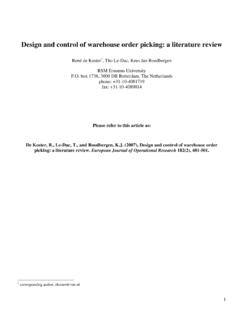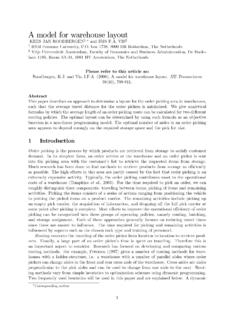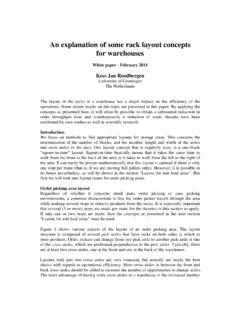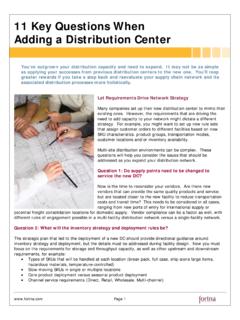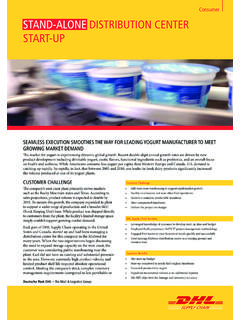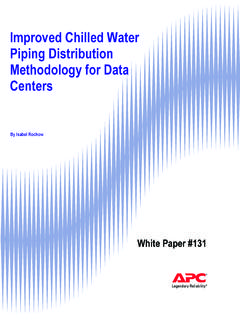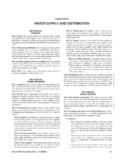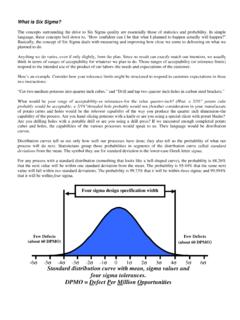Transcription of Reduction of walking time in the distribution center of De ...
1 Reduction of walking timein the distribution center of De BijenkorfRen de Koster 1, Kees Jan Roodbergen 1 and Ronald van Voorden 21 Erasmus University Rotterdam, Rotterdam School of Management, Box 1738,3000 DR Rotterdam, The Netherlands2 Districon , Raadhuisstraat 32-34, 3603 AW Maarssen, The NetherlandsPublished in: New trends in distribution logistics, Speranza and P. St hly(eds.), Springer, Berlin, In many distribution centers, there is a constant pressure to reduce theorder throughput times. One such distribution center is the DC of De Bijenkorf, aretail organization in The Netherlands with 7 subsidiaries and a product assortmentof about 300,000 SKUs (stock keeping units). The orders for the subsidiaries arepicked manually in this warehouse, which is very labor intensive. Furthermoremany shipments have to be finished at about the same time, which leads to peakloads in the picking process.
2 The picking process is therefore a costly this study we have investigated the possibilities to pick the orders moreefficiently, without altering the storage or material handling equipment used or thestorage strategies. It appeared to be possible to obtain a Reduction between 17 and34% in walking time, by simply routing the pickers more efficiently. The amountof walking time Reduction depends on the routing algorithm used. The largestsaving is obtained by using an optimal routing algorithm that has been developedfor De Bijenkorf. The main reason for this substantial Reduction in walking time, isthe change from one-sided picking to two-sided picking in the narrow is even possible to obtain a further Reduction in walking time by clustering theorders. Small orders can be combined on one pick cart and can be picked in asingle route.
3 The combined picking of several orders (constrained by the size ofthe orders and the cart capacity) leads to a total Reduction of about 60% in walkingtime, using a simple order clustering strategy in combination with a newlydeveloped routing strategy. The Reduction in total order picking time and hence thereduction in the number of pickers is about 19%.Keywords. warehouse, order picking, routing, batching, case IntroductionIn many warehouses and distribution centers, short order throughput times are ofcrucial importance. There are several causes for this. Suppliers of manufacturing companies are being forced to supply in a just-in-time manner. Their customers have lowered their inventories and demand arapid and timely supply from their vendors. Many internationally operating companies have centralized their Europeandistribution in so-called EDCs, European distribution centers.
4 These EDCs areresponsible for the warehousing function and distribution to multiple Europeancountries. The internal process organization often leads to wave picking, inwhich the pick process is carried out in batch, governed by fixed truck departuretimes for the different countries or regions. In order for these trucks to leave intime, the orders must be ready before departure, regardless of their , in practice it can often be observed that there is a peak of departuresin the afternoon and of receipts in the morning. This leads to order pickingprocesses that are capable of handling peak loads in a timely manner. In contrast to the above way of working in EDCs, customer sales does not wantany concession in the customer service and simultaneously wants to guaranteeshort delivery times (overnight for customers in a radius of 500 km of theEDC).
5 This leads to order cut off times that are as late as possible before thetruck departure times. Often special procedures are created to be able to handlelate emergency orders in time. Short delivery times are considered in many branches as a competitive puts pressure on the internal throughput times, especially order pickingthroughput times. It becomes more and more difficult to realize short order throughput timesbecause of factors such as a gradual increase in assortment and smaller, yetmore frequent, orders. For the increasing assortment an increasing amount offloor space is necessary. This in turn results in increased walking times perorder. Smaller orders (less items per line) and an increased frequency ofordering lead to an increase in the work contents of order picking: less fullpallets can be picked and more single item picks are necessary.
6 The increase of value added logistics (VAL) activities in many warehouses haslead to additional activities that have to be carried out during or after the orderpicking. These additional activities often lead to the necessity of picking andhandling such orders separately, within the short time frame available forhandling the orders. Especially in the retail business, the increased application of ECR (efficientconsumer response) concepts has lead to the direct transmission of orderinformation from scanning cash registers to the distribution centers. Theseorders are then translated in replenishment instruction from the DC to the often means more, but smaller orders that have to be warehouses are gradually confronted with the above mentioneddevelopments. It is important to find an adequate solution to maintain short andwell-controlled throughput times.
7 One such option is a radical new designconsisting of a new layout, further mechanization and automation of , often also by less radical methods the efficiency of the order pickingprocess can be this paper, a number of methods are discussed that can help improving theefficiency of the order picking process, without layout change, or a change ofstorage policies or of material handling equipment. Order picking is, in mostcompanies, a manual job. By a better organization of the process, a more efficientorder picking, it is often possible to obtain a substantial Reduction of the orderthroughput time. According to Tompkins et al. (1996) the operation costs inwarehouses are determined to a large extent by the order picking process(approximately 55%).The efficiency of the order picking process depends on factors that are difficultto change, such as the chosen storage systems (racks), the layout, the order pickingsystem (order picking trucks, pick carts, pick-to-belt, pick-to-light, etc.)
8 , but alsoby parts that are more easily changeable, such as the storage strategy (the storagelocation determination), the sequence by which items are collected from storagelocations (routing strategy) and the possible clustering of customer orders in asingle order picking route (batching).In section 2, these relatively simple strategies are considered in more detail. Insection 3 it is demonstrated by the case of the distribution center of De Bijenkorf in Woerden, The Netherlands, that proper choices for these parts can lead to strongimprovements in the efficiency of the order picking process. In this case study thefocus is on routing and batching strategies. In section 4 some conclusions Reduction of the order pick time in distribution centersOrder picking and shipping customer orders within an agreed time is the corefunction of a distribution center .
9 In the picking process, customer orders areconverted into pick time, needed for picking an order can be split in travel time ( walking ordriving time), pick time and remaining time. The travel time is related to themovement between locations that have to be visited (where the items are storedthat have to be picked). The pick time is related to grabbing the items. Thisincludes search for the article, grabbing the units, depositing them on the pick cart,checking the pick, administration of the pick on the pick list (if applicable) andreading the next location to be visited. The remaining time is related to activitiessuch as the acquisition of the pick order, dropping off the full pick cart, waitingtime for a next assignment, social contacts to Tompkins et al. (1996), the travel time in a warehouse is, ingeneral, responsible for half the total order picking time (see table 1).
10 Hence, Reduction of the travel distances and therefore of the travel times has a significantimpact on the total order picking time. In a stepwise approach for gradualimprovement of the order picking process, walking distance Reduction is animportant 1. Typical distribution of an order picker s time (according to Tompkins et al.(1996)). 01020304050 TravelSearchPickSetupOther% of orderpicker s time There are several ways to reduce the travel distances in the order pickingprocess in a warehouse. It is possible to reduce walking distances by systemchanges, using a higher degree of automation. Examples are the use of A-frames(automatic product dispensers) for automated picking of small articles, AS/RSwarehouses, miniloads and carousel systems, in which the items that have to bepicked are automatically moved to the picker ( goods-to-man ), or the use of pick-to-belt order picking combined with automatic the other hand it is also possible to reduce walking times by less radicalchanges.
